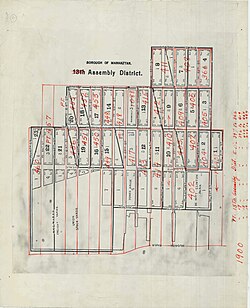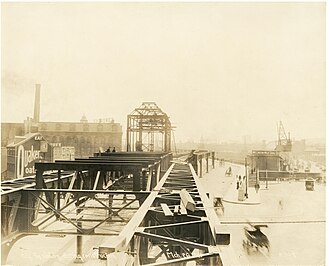
The 1900 United States Census was the 12th decennial census of the United States. It surveyed the U.S. population as of June 1, 1900. The census determined the population to be 76,212,168, an increase of 21% since the previous federal census in 1890.[1]
The census covered the continental United States, as well as organized territories, including Washington D.C., Alaska, Hawaii and "Indian Territory."[2] The U.S. military enumerated active personnel, both within the United States and abroad, and institution enumerators tracked those at large institutions such as prisons and hospitals.[2] Puerto Rico and Cuba were not included, but the War Department conducted a census in those territories in 1899.[3]
The 1900 U.S. Census can be searched on MyHeritage.
Research your ancestors on MyHeritage
Historical significanceHistorical significance

The 1900 U.S. Census took place after the conclusion of the Spanish-American War (1898).
The census found that the U.S. population was about 40% urban and 60% rural; cities were growing and the urbanization of America would continue in the decades that followed.[4]
Due to the loss of the majority of the 1890 U.S. Census from a fire, the 1900 U.S. Census is a valuable resource for genealogists researching this time period.[5]
The 1900 U.S. Census kicked off a decade which included the assassination of President William McKinley (1901), the publishing of The Entertainer by Scott Joplin (1902), the debut of the first silent film (1903), the first airplane flight by Orville Wright and Wilbur Wright (1903), the opening of the New York City subway (1904), the Great San Francisco Earthquake (1906), and Henry Ford starting production of the Model T (1908).[1]
Header informationHeader information

| 1. State | 7. Supervisor District # |
| 2. County | 8. Enumeration District # |
| 3. Township or Division of County | 9. Sheet # |
| 4. Institution Name, if applicable | 10. Enumeration Date |
| 5. Name of Incorporated Place | 11. Enumerator |
| 6. Ward of City |
The header of the 1900 U.S. Census provides location information, sheet number, and the name of the enumerator.
Column informationColumn information
LocationLocation
Column 1 described the Location. It is divided into 4 smaller columns:
- Street name (written vertically)
- House number, if applicable
- Number of dwelling in order of visitation
- Number of family in order of visitation
Vital informationVital information
Columns 2-6 are related to each individual. They include:
- Column 2: Name: Each person living in the place of abode as of June 1, 1900. Typically recorded as surname first, then given name.
- Column 3: Relation: How the person is related to the head of the family.
- Column 4: Personal Description: Divided into smaller columns:
- Color or race.
- Sex, male or female.
- Date of birth: Month and year.
- Age at last birthday.
- Whether single, married, widowed, or divorce.
- Number of years in present marriage.
- For mothers, total number of children born, number of children living now.
- Column 5: Nativity: Place of birth for the person, their father and their mother.
- Column 6: Citizenship: Year of immigration to the United States, number of years in the United States, and whether naturalized or alien, if applicable.
Work informationWork information
Column 7 was dedicated to work for each person:
- Occupation, trade or profession for each person 10 years of age and older.
- Number of months not employed.
Additional questionsAdditional questions
Columns 8-9 covered the following:
- Column 8: Education: Divided into smaller columns:
- Attended school (in months).
- Can read.
- Can write.
- Can speak English.
- Column 9: Ownership of home: Divided into smaller columns:
- Owned or rented.
- Owned free or mortgaged.
- Farm or house.
- Number of farm schedule.
Citing the 1900 U.S. CensusCiting the 1900 U.S. Census
Here is an example of a citation for the 1900 U.S. Census:
1900 U.S. census, [County], [State], [Location], Population Schedule, [Enumeration District #], [Page #], [Dwelling #], [Family #], [Name of Person]. National Archives of the United States.
See alsoSee also
Explore more about 1900 United States CensusExplore more about 1900 United States Census
- Search the 1900 United States Federal Census on MyHeritage
- Ask The Expert – How To Work with U.S. Census Records on MyHeritage
References
- ↑ 1.0 1.1 Pop Culture: 1900. History. United States Census Bureau. https://www.census.gov/history/www/through_the_decades/fast_facts/1900_fast_facts.html
- ↑ 2.0 2.1 Information about the 1900 Census, Decennial Census Official Publications. United States Census Bureau. https://www.census.gov/programs-surveys/decennial-census/decade/decennial-publications.1900.html
- ↑ 1900 Overview, History. United States Census Bureau.https://www.census.gov/history/www/through_the_decades/overview/1900.html
- ↑ Urban Growth and Rural America. CDS, Community Development Strategies. https://www.cdsmr.com/newsworthy/urban-growth-and-rural-america
- ↑ 1890 Overview, History. United States Census Bureau. https://www.census.gov/history/www/through_the_decades/overview/1890.html


